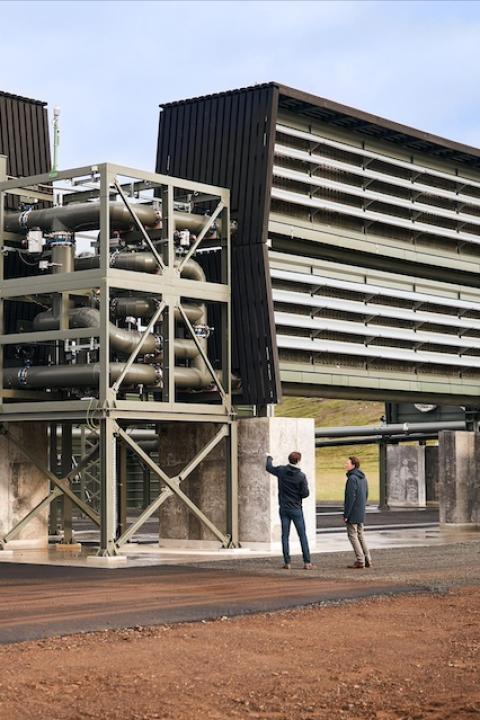
President Joe Biden and union members building Intel's Ocotillo Campus walk onstage before announcing $20 billion in investments to ramp up production of semiconductor chips on March 20, 2024, in Chandler, Arizona. Another $20 billion in funding geared toward clean technology investments in underserved communities was announced last week. (Official White House Photo by Adam Schultz via Flickr)
The 2022 Inflation Reduction Act provides billions in public subsidies to corporate citizens for new clean technology investments. It also sets up so-called “green bank” financing programs focused on disadvantaged communities. Republicans in Congress have taken steps to dismantle it, but they may want to crack open a history book before they go any further. The green bank formula is rooted in public initiatives that transformed parts of the U.S. Southeast from deep poverty in the early 20th century to the economic powerhouse of today, much to the benefit of businesses and individuals alike.
The 2022 Inflation Reduction Act and taxpayer support for businesses
Democratic members of Congress initially introduced the 2022 Inflation Reduction Act under the catchphrase “Build Back Better,” promoting it as President Joe Biden’s signature climate action legislation. No Republican members of Congress voted to support it, even after Democratic Sen. Joe Manchin advocated to weaken its provisions.
The opposition included the Republican Congressional delegation from Tennessee. “Senate Democrats have forced through a socialist agenda that will make life more difficult and expensive for Tennesseans,” U.S. Sen. Marsha Blackburn of Tennessee said when explaining her vote against the bill.
U.S. Rep. John Rose of Tennessee's sixth district chose to focus more narrowly on the cost of the legislation. “Amidst a spending-induced recession and record-breaking price increases for everything, Democrats doubled down on their disastrous policies by ramming through a bill that costs taxpayers hundreds of billions of dollars on a party-line vote that will only make matters worse,” he said.
Rose’s opposition to taxpayer-funded programs is particularly ironic considering that he describes himself as an “eighth-generation farmer.” Farms in his Congressional district have received millions in public subsidies over the past 30 years. The Environmental Working Group compiled data from the U.S. Department of Agriculture which indicates “farms in 6th District of Tennessee (Rep. John Rose) totaled $135,717,000 from 1995 through 2021.”
Tennessee reaps the rewards of the Biden-Harris “Invest in America” initiative
Regardless of the partisan opposition, news reports indicate Republican-led states are receiving an outsized share of benefits under the Inflation Reduction Act, including states located in the Southeast.
“Whereas Southern states led by Republicans did not vote for climate spending, they are embracing clean energy dollars a lot more than their blue counterparts," Oil Price reporter Alex Kimani noted last year. States including Tennessee, Georgia, Kentucky, Indiana, Michigan, Ohio and the Carolinas even earned the name the “battery belt" for their recent electric vehicle and EV battery investments, Kimani reported.
To be clear, the Inflation Reduction Act is just a third of the Biden-Harris administration’s Invest in America Agenda. The other two pillars are the Bipartisan Infrastructure Law and the Creating Helpful Incentives to Produce Semiconductors (CHIPS) Act, both of which received a modicum of bipartisan support. In a recap issued last year, the U.S. Treasury Department reported that “real manufacturing construction spending has doubled” under the Invest in America agenda.
The U.S. Department of Energy also drilled down into the benefits of Invest in America for the manufacturing sector in Tennessee in particular, noting that the state has attracted $14 billion in investment in the EV battery supply chain alone. Among the supply chain manufacturing highlights, the Energy Department awarded $150 million to Novonix Anode and $141 million to Piedmont Lithium to set up shop in Tennessee.
The U.S. green bank started with the 1933 Tennessee Valley Authority Act
Tennessee’s agriculture industry is also gaining benefits from Invest in America. “Thanks to Inflation Reduction Act funding, more farmers and more acres are enrolled in voluntary conservation practices than at any single point in history,” the U.S. Department of Agriculture's Fiscal Year 2023 update reads. Even with this "unprecedented funding," the agency says it's "seeing more demand than we have funds to support."
That means “more farmers, rural businesses, utilities and electric cooperatives will also be able to reduce their energy costs, leaving more dollars in the hands of rural communities,” the USDA added in its update.
That reference to electric cooperatives is important. Rural communities in Tennessee and much of the surrounding region were mired in poverty until the Tennessee Valley Authority Act of 1933 established a series of publicly-funded dams to reduce flooding and produce electricity “at reasonable rates” for farms and villages in the region. That was followed by the 1936 Rural Electrification Act, which provided federal funding to set up distribution networks elsewhere in the country.
When private utilities balked at investing in sparsely populated areas, local farmers formed cooperatives to apply for the funds. The Franklin D. Roosevelt administration encouraged them under the 1937 Electric Cooperative Corporation Act. To this day, 900 member-owned, not-for-profit rural electric cooperatives and related entities cover 56 percent of the U.S. landmass and serve around 42 million people.
Electric cooperatives also represent 92 percent of the counties classified as “persistent poverty” counties. These are exactly the counties that stand to benefit under the new green bank initiative led by a new round of $20 billion in competitively awarded federal grants to eight organizations through the Inflation Reduction Act, announced by the U.S. Environmental Protection Agency on April 4.
Together, the funds comprise a “national clean financing network for clean energy and climate solutions across sectors,” the EPA's announcement reads. “By financing tens of thousands of projects, this national clean financing network will mobilize private capital to reduce climate and air pollution while also reducing energy costs, improving public health, and creating good-paying clean energy jobs in communities across the country, especially in low-income and disadvantaged communities."
The green bank in action
The EPA split the $20 billion between two programs. Of the total, $14 billion is earmarked for three organizations under the National Clean Investment Fund. These three organizations — Climate United Fund, Coalition for Green Capital and Power Forward Communities — have been created in partnership with United Way, Habitat for Humanity, and other experienced community groups. They are tasked with establishing new financial institutions that provide “accessible, affordable financing for clean technology projects nationwide.”
The remaining $6 billion goes to five organizations through a program called the Clean Communities Investment Accelerator. This group will create assistance hubs for community lenders, with the aim to get some projects off to a quick start while developing sustainable, long-term financing platforms for future projects.
Four of the awardees — the Opportunity Finance Network, Inclusiv, Appalachian Community Capital and the Native CDFI Network — have years or even decades of experience in community finance and credit unions. The EPA describes the fifth organization, called Justice Climate Fund, as a “purpose-built nonprofit” supported by an existing member network and more than 1,200 community lenders with decades-long track records, as well as the experienced nonprofit asset manager ImpactAssets.
The bar is set high: Will the private sector responds?
Last week, Associated Press reported that Republicans lawmakers in the House of Representatives have called the new funding program a “slush fund” and took steps to repeal the green bank along with “other parts of President Joe Biden’s climate agenda.”
They may have to deal with pushback from their own constituents. Rural electric cooperatives have already leveraged their community-centered business model to take a leadership role in the nation’s renewable energy transition through funding from both the USDA and the Energy Department. More likely than not, they will also play a decisive role in the success of the new green bank initiative.
As for private-sector investors, money talks, and it is talking about rural communities. A new analysis by the organization E2 indicates that the Inflation Reduction Act is already expected to stimulate $20 billion in private-sector investments related to large-scale clean technology investments in rural counties.

Tina writes frequently for TriplePundit and other websites, with a focus on military, government and corporate sustainability, clean tech research and emerging energy technologies. She is a former Deputy Director of Public Affairs of the New York City Department of Environmental Protection, and author of books and articles on recycling and other conservation themes.














